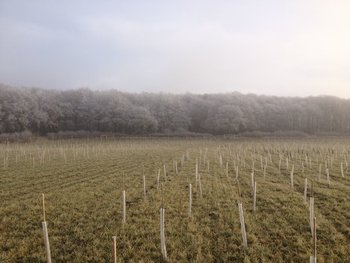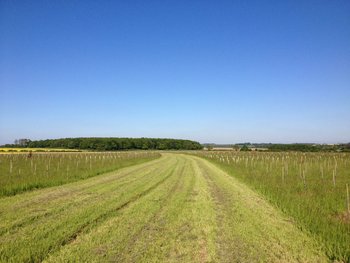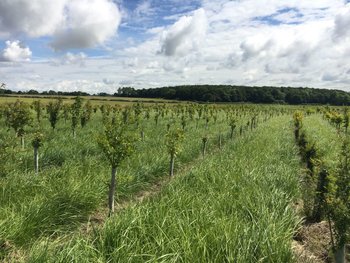Bescaby Diamond Wood
Summary
About the site
Carbon Buyers - Why buy from this project?
Landowners - Why get involved in the WCC?
Who is involved?
How we go about it
Wider benefits
Summary
Unique ID: 103000000004461
Status: Validated / Active
Project Developer: Lockhart-Garratt Ltd
Project Location: Located close to Saltby in North Leicestershire.
Previous Land Use: Arable ground
New woodland area: Gross 13.4ha: Net planted 12.1ha; Open 1.3ha.
Species Mix: 31% Oak, 26% Beech, 39% other mixed broadleaves, 4% mixed conifer (Douglas fir, Scots pine and Norway spruce).
Woodland Management: Continuous cover
Estimated Sequestration: 3,918 tCO2e over 100 years, of which 2,939 tCO2e is for sale, 979 tCO2e to the WCC Buffer.
Start Date: Planted March 2012- February 2013.
About the site
Bescaby Wood is located on Saltby Estate, owned by the de Capell Brooke family and situated between the market towns of Melton Mowbray and Grantham. It is one of the Woodland Trust’s ‘Diamond Woods' planted to celebrate the Queen’s 2012 Diamond Jubilee. This project builds on existing woodland stretching out from the estate buildings connecting with the mature Bescaby Oaks.
Saltby Estate is predominately in arable production with several small spinneys across the landscape and the existing Bescaby Oaks forming an 11 hectare centrepiece of mature semi-natural broadleaved woodland.
Bescaby Oaks Diamond Wood was created with multiple objectives: carbon sequestration, landscape enhancement, timber production, biodiversity and public enjoyment all play a part in its design and future.
The woodland at Bescaby was designed in line with a longer-term landscape plan for the estate to create a large parkland environment, framing what is currently intensive arable production. The decision to convert a significant area of productive arable land into woodland was not taken lightly. However, the opportunity to celebrate the Jubilee with this permanent and ever developing project was something the family was keen to undertake and excited about being part of.
 Bescaby Wood just after planting in December 2012. Photo: Lockhart-Garratt Ltd
Bescaby Wood just after planting in December 2012. Photo: Lockhart-Garratt Ltd
Carbon buyers - Why buy from this project?
It is predicted that over 3,918 tonnes of atmospheric CO2 will be removed helping to combat climate change. By buying carbon from this project, buyers are also contributing to the conservation and enhancement of a traditional English estate landscape, securing the production of beautiful hardwood timber in the future and ensuring the continued development of attractive woodland that can be viewed from the many public footpaths around the site.
Landowners - Why get involved in the WCC?
Not only does the creation of this wood add to Jubilee Woods across the country, it also creates valuable conservation habitat in a county that has low woodland cover.
Forestry Consultants, Lockhart Garratt Ltd, said: "Any woodland project works on a long timescale, and when creating new woodland it is critical to consider the likely future policy developments, particularly with regard to carbon. By registering the rights to report carbon sequestration soon after planting, owners are future-proofing their woods by ensuring they can take advantage of new income opportunities as carbon markets develop. The wider the breadth of products which can be obtained from a given range of species, the more secure the income stream. As ever, a woodland which pays is a woodland which stays."
Who is involved?
The de Capell Brooke family worked closely with the Woodland Trust and Lockhart-Garratt Ltd who developed the Woodland Carbon Code project.
How did we go about it?
The project was planted with trees protected by shelters, with the main plantations surrounded by deer fence. This gives the trees the best possible start and also prevents browsing by deer and rabbits. Pedestrian gates within the fence have maintained access.
The ground was prepared for planting using low impact techniques to limit carbon release into the atmosphere. Managed open space was created within the project which, when mown on an annual basis, will provide valuable habitat for butterflies and wild flowers.
The wood includes 5,000 Oak trees, selected from seed stands for their quality. These will provide good quality timber in future, supplying demand for high quality English Oak. Although the wood contains ‘typical’ native broadleaved and conifer species, some less common species (for example, purple beeches, dawn redwoods and wild service tree) are also present to add visual variety and biodiversity.
As the woodland grows, it will be thinned to create a healthy woodland structure and eventually maintain woodland cover through a continuous cover forestry system offering shelter for many species of wildlife.
 Bescaby Wood in June 2013: Photo Lockhart-Garratt Ltd
Bescaby Wood in June 2013: Photo Lockhart-Garratt Ltd
What are the wider benefits?
The previous land use of arable farming involved annual ploughing, which generated carbon emissions. Converting to woodland has stopped these activities and emissions; the project will also store significant quantities of carbon.
The project will create a haven for wildlife, particularly as the woodland will be managed on a continuous cover basis, with no clearfelling. This protects the soil and greatly increases the biodiversity by providing a wide range of habitat niches in an area with low woodland cover.
The four bodies of woodland were designed to create a highly scenic parkland environment, in line with the larger estate woodland management plan. This is a valuable addition to parkland at a time when many historic parks and gardens are under threat.
Local schools are a major user; children visit the woodland to learn more about local wildlife and ecology. By encouraging a new generation to understand and value the growing of woods and trees, it is hoped that the sustainable future management of these woods will be secure.
 Bescaby Wood taking shape in July 2016. Photo: Lockhart-Garratt Ltd
Bescaby Wood taking shape in July 2016. Photo: Lockhart-Garratt Ltd

